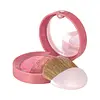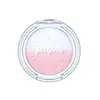What's inside
What's inside
 Key Ingredients
Key Ingredients

 Benefits
Benefits

No benefits
 Concerns
Concerns

 Ingredients Side-by-side
Ingredients Side-by-side

Synthetic Fluorphlogopite
Talc
AbrasiveHectorite
AbsorbentZea Mays Starch
AbsorbentParfum
MaskingPentylene Glycol
Skin ConditioningCaprylyl Glycol
EmollientMagnesium Aluminum Silicate
AbsorbentVinyl Dimethicone/Methicone Silsesquioxane Crosspolymer
Magnesium Carbonate Hydroxide
BufferingHydroxycitronellal
PerfumingTin Oxide
AbrasiveCinnamyl Alcohol
PerfumingEugenol
PerfumingBenzyl Salicylate
PerfumingLinalool
PerfumingAlpha-Isomethyl Ionone
PerfumingCitronellol
PerfumingGeraniol
PerfumingAmyl Cinnamal
PerfumingHexyl Cinnamal
PerfumingCoumarin
PerfumingEvernia Prunastri Extract
PerfumingBenzyl Benzoate
AntimicrobialLimonene
PerfumingCI 77891
Cosmetic ColorantIron Oxides
Mica
Cosmetic ColorantCI 15850
Cosmetic ColorantCI 77007
Cosmetic ColorantCI 19140
Cosmetic ColorantCI 75470
Cosmetic ColorantSynthetic Fluorphlogopite, Talc, Hectorite, Zea Mays Starch, Parfum, Pentylene Glycol, Caprylyl Glycol, Magnesium Aluminum Silicate, Vinyl Dimethicone/Methicone Silsesquioxane Crosspolymer, Magnesium Carbonate Hydroxide, Hydroxycitronellal, Tin Oxide, Cinnamyl Alcohol, Eugenol, Benzyl Salicylate, Linalool, Alpha-Isomethyl Ionone, Citronellol, Geraniol, Amyl Cinnamal, Hexyl Cinnamal, Coumarin, Evernia Prunastri Extract, Benzyl Benzoate, Limonene, CI 77891, Iron Oxides, Mica, CI 15850, CI 77007, CI 19140, CI 75470
Talc
AbrasiveMica
Cosmetic ColorantAluminum Starch Octenylsuccinate
AbsorbentSynthetic Fluorphlogopite
Boron Nitride
AbsorbentSilica
AbrasiveDimethicone
EmollientMagnesium Stearate
Cosmetic ColorantDiisostearyl Malate
EmollientTitanium Dioxide
Cosmetic ColorantPhenyl Trimethicone
Skin ConditioningDipentaerythrityl Hexahydroxystearate/Hexastearate/Hexarosinate
Skin ConditioningGlyceryl Caprylate
EmollientCaprylyl Glycol
EmollientTrimethoxycaprylylsilane
SmoothingUltramarines
Aluminum Hydroxide
EmollientCI 19140
Cosmetic ColorantTalc, Mica, Aluminum Starch Octenylsuccinate, Synthetic Fluorphlogopite, Boron Nitride, Silica, Dimethicone, Magnesium Stearate, Diisostearyl Malate, Titanium Dioxide, Phenyl Trimethicone, Dipentaerythrityl Hexahydroxystearate/Hexastearate/Hexarosinate, Glyceryl Caprylate, Caprylyl Glycol, Trimethoxycaprylylsilane, Ultramarines, Aluminum Hydroxide, CI 19140
Ingredients Explained
These ingredients are found in both products.
Ingredients higher up in an ingredient list are typically present in a larger amount.
Caprylyl Glycol is a humectant and emollient, meaning it attracts and preserves moisture.
It is a common ingredient in many products, especially those designed to hydrate skin. The primary benefits are retaining moisture, skin softening, and promoting a healthy skin barrier.
Though Caprylyl Glycol is an alcohol derived from fatty acids, it is not the kind that can dry out skin.
This ingredient is also used as a preservative to extend the life of products. It has slight antimicrobial properties.
Learn more about Caprylyl GlycolCI 19140 is also known as Tartrazine. Tartrazine is a synthetic dye used in cosmetics, foods, and medicine to add a yellow color.
Tartrazine is created from petroleum and is water-soluble.
Some people may experience allergies from this dye, especially asthmatics and those with an aspirin intolerance.
Learn more about CI 19140Mica is a naturally occurring mineral used to add shimmer and color in cosmetics. It can also help improve the texture of a product or give it an opaque, white/silver color.
Serecite is the name for very fine but ragged grains of mica.
This ingredient is often coated with metal oxides like titanium dioxide. Trace amounts of heavy metals may be found in mica, but these metals are not harmful in our personal products.
Mica has been used since prehistoric times throughout the world. Ancient Egyptian, Indian, Greek, Roman, Aztec, and Chinese civilizations have used mica.
Learn more about MicaSynthetic Fluorphlogopite is the synthethic version of mica. It consists of fluorine, aluminum and silicate.
Synthetic Fluorphlogopite is used to add volume to products.
It is considered non-irritating on the skin.
Learn more about Synthetic FluorphlogopiteTalc is a clay mineral. It helps absorb moisture and improve the texture of products. Like other types of clay, Talc can have a slight exfoliating effect on skin. Talc can be added to increase the volume of products.
Some Baby powders are made by combining talc with corn starch. The word "talc" comes from Latin and originates from Arabic. Talc is a mineral commonly found throughout the world.
If you have any concerns about using talc, we recommend checking out the FDA's official page.
Learn more about Talc